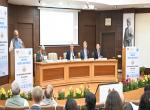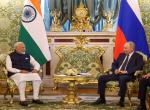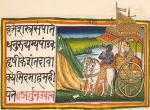The initial round of bilateral discussion on the India-US BTA (Bilateral Trade Agreement) concluded on March 29, after intense discussions between the two country’s delegation.
Not much is known about the final results of the four-day talks other than a neutral statement from the Indian Ministry of Commerce and Industry that “In order to realize the shared objective of promoting growth that ensures fairness, national security and job creation, both sides have through four-days of discussions in New Delhi broadly come to an understanding on the next steps towards a mutually beneficial, multi-sector Bilateral Trade Agreement (BTA), with the goal to finalize its first tranche by fall 2025.” Except that the meeting was convened “As a follow up to the India-U.S. Joint Statement of 13 February 2025, wherein the two sides agreed to expand bilateral trade to reach $ 500 Billion by 2030”.
Although there were speculations about the meeting and what it would mean for the planned April 2 announcement by Trump on Reciprocal Tariffs by the US on its trading partner/neither side mentioned anything about any discussion on tariffs except in broad terms.
This was quite understandable for a number of reasons. First, Trump and the US government were then still working on finalising the final announcement, working out the modalities and contours of the such reciprocal tariffs. The only thing known was Trump’s unhealthy obsession with tariffs and trade, especially in respect of the trade deficits run by the US. He has been emphasising three recurring themes regarding trade policy: the importance of trade balances, including bilateral trade balances, currency manipulation to gain unfair advantage in trade, and “disastrous” trade agreement. Two, given the temperament and fickleness of Trump’s actions so far in respect of tariffs, it was quite likely that even he did not know exactly what he would do on April 2.
All that was known till the announcement was made was the comment made by the President on Air Force One on Sunday to a group pf press persons accompanying him that “You’d start with all countries,” “So let’s see what happens. There are many countries” without qualifying what was meant by “all”. However, as a practical matter, although this has been not known as a factor in influencing the President’s actions, it would be impossible to simultaneously apply matching US Reciprocal Tariffs on all the 200+ countries with whom US has trading relations. Instead, the president or his trade advisors would have likely prioritized countries based on the degree of positive impact that these reciprocal tariffs would have on the US economy and trade deficit and even in that context which of the three elements of his trade policy should be given more importance can only be decided by Trump.
For weeks Trump has promoted April 2, as “Liberation Day” in America when the new tariff plans will be announced. However, based on previous Trump’s public statements, April 2 is at least the third “liberation day” that he has identified. At a rally last year in Nevada, he said the day of the presidential election, Nov. 5, would be “Liberation Day in America.” He later gave his inauguration the same label, declaring in his address: “For American citizens, Jan. 20, 2025, is Liberation Day.
So where did India figure in this debate.
There is a feeling in India, in both official and public space, that Modi enjoys a special relationship with Trump and hence India would be treated leniently on tariffs. On the matter of friends and enemies, Trump does not have any permanent loyalties, only permanent Trump Interests. After all it was Trump who, as President, sat idly by when a mob his loyal supporters went on rampage and stormed the Capitol chanting “Hang Pence, Hang Pence”.
A dispassionate and objective reading of facts and Trump’s (and his advisors) ideologies on the issue of trade and tariffs would have indicated that not only India will not be treated leniently but in fact would be singled out among the countries specially targeted – although it is admitted here freely that Trump’s actions do not always follow logic or facts!
This conclusion could have been made from an analysis of some of the conclusions drawn in a study “The United States Reciprocal Trade Act: Estimated Job & Trade Deficit Effects” done in 2019 by Peter Navarro, who was then the Director of White House Office of Trade and Manufacturing Policy and is currently a favourite of Trump and now his “Senior Counsellor for Trade and Manufacturing” and had the study done in support of the Reciprocal Trade Act (RTA) which had been then just introduced in the Congress but which was never passed during the last year of Trump’s first term as President, principally because the Republicans had lost control of the House. Now with the majority in both the Congress and Senate, RTA is most likely to become law soon.
What were the main outcomes of this study which, as far as this author knows, was the only kind of study on reciprocal tariffs? Of the 132 countries -with which the US did not have free trade agreements and which accounted for in 2018 over 60% percent of total US trade and 98% of US trade that were not covered by FTAs- that were included in the study, the percent of product lines where the partner country charged higher rates than US was highest in India and China. Of the 5388 HS6 product lines that figured in the bilateral US-India trade in 2018, India charged higher rates of Tariff in 4845 product lines (90 %) while US charged a higher rate in only 360 (7 %) product lines. China charged a higher rate than US in 4592 (85 %) of the product lines and US charged a higher rate in 8 % of the traded product lines. The study concluded that collectively, these higher non-reciprocal tariffs in China and India blocked American exporters from selling goods at competitive prices to more than one-third of the world’s population.
The study also simulated the the trade deficit reductions under two scenarios relying on the World Bank’s SMART tariff simulator. Scenario One assumed US trading partners lowered their applied tariff rates on specific products to US levels in cases where their applied tariffs are higher. Scenario Two assumed US trading partners refused to lower their tariff rates to match those of the US. Instead, in order to uphold the principle of reciprocity, the US raised its tariffs to mirror levels.
While the deficit reductions- as percentage of 2018 deficit -were only modest when applied to world as a whole ((9.4 % under scenario 1 and 10.2 % under scenario 2), the results were much more dramatic when applied to individual countries. The largest absolute dollar reductions in bilateral trade deficits came from applying the USRTA first to China and then to the EU. The results were far more significant in relative terms. The largest relative dollar reductions in percent terms come from applying the USRTA first to India and then to Taiwan and Vietnam. For example, if India were to reduce its tariffs to US levels, as in Scenario One, this would have reduced the bilateral trade deficit with India by 24%. If the US raised its tariffs to mirror India’s levels, the result would be a far more dramatic 88%. reduction in the US bilateral trade deficit with India
The RTA study was very critical of India’s trade and tariff policies. Given the fact Peter Navarro occupies a very senior position in the Trump administration and is a favourite of President Trump- for whatever it is worth (he is one of very few former associates who underwent prison terms in support of Trump), his advice would be considered seriously.
For these reasons, even though the final word on reciprocal tariffs was not announced till April 2, India should have seriously considered the scenario where it is singled out along with one or two more countries for reciprocal tariffs and thought out a plan which would have resulted in lower Indian trade surplus in the long run, rather than emphasising only increasing the bilateral trade level substantially to higher levels without assuring Trump how that need not necessarily result in even higher trade deficits.
(The paper is the author’s individual scholastic articulation. The author certifies that the article/paper is original in content, unpublished and it has not been submitted for publication/web upload elsewhere, and that the facts and figures quoted are duly referenced, as needed, and are believed to be correct). (The paper does not necessarily represent the organisational stance... More >>
Image Source: https://www.marketplace.org/wp-content/uploads/2025/03/trumptariffs-scaled.jpg?w=350










Good article Bala sir
Post new comment